Confluence URL Reports
Overview
Track specific components of your Confluence, including dashboards, user profiles, calendars, people or space directories, and content from 3rd-party apps.
Set your desired tracking of a distinct URL or use regular expressions (regex) to track different URLs together based on pattern match.
Share the reports of the different URL trackings with all colleagues or only specific user groups.
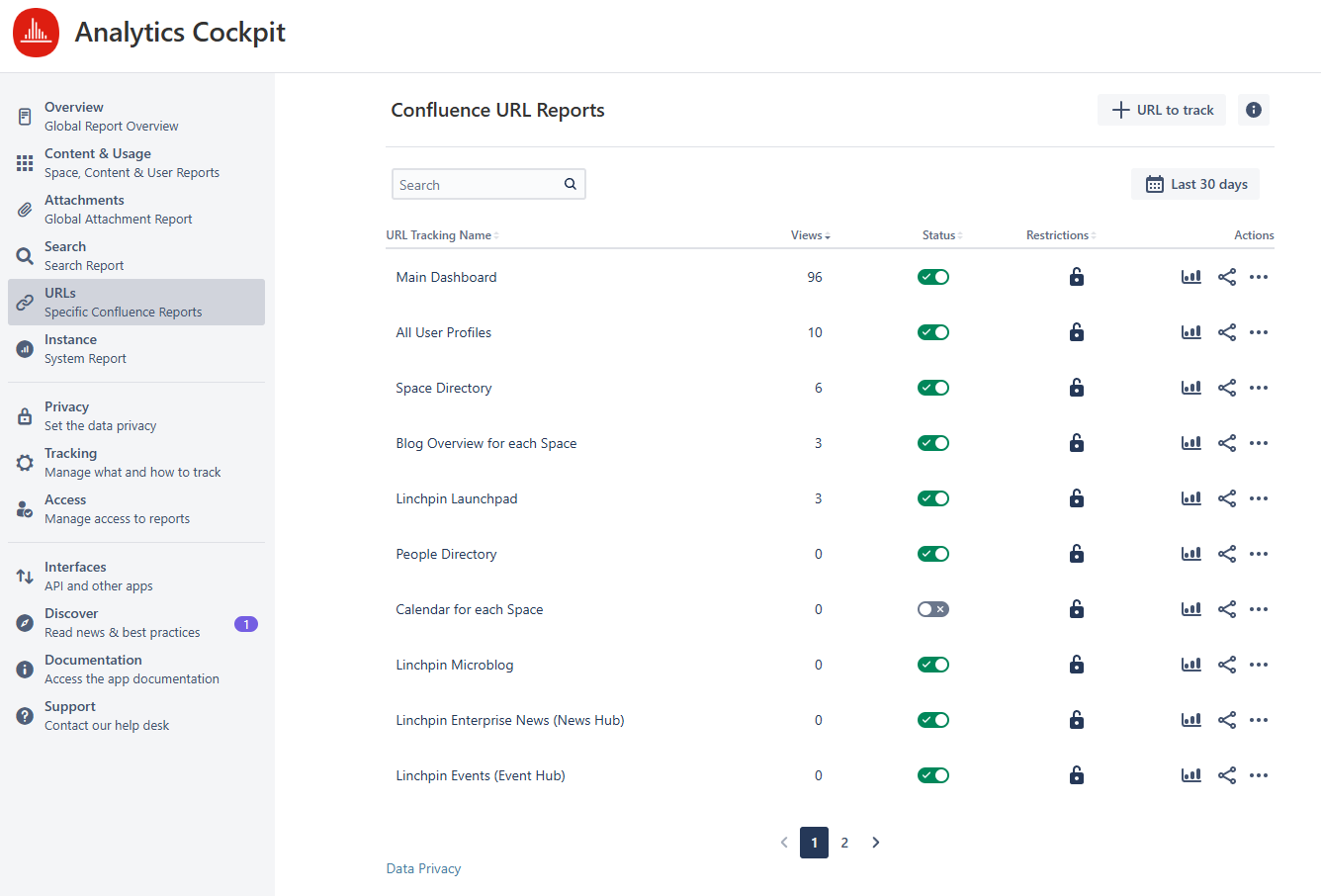
Screenshot of the URL report
Accessing the Confluence URL Reports
In the Viewtracker menu, select the entry “URLs / Specific Confluence Reports”.
This will give you a table of all specific Confluence reports.
The metrics refer to the last 30 days (default).
You can change the date range by tapping the “Last 30 days” field.
You can use the search field to filter the reports.
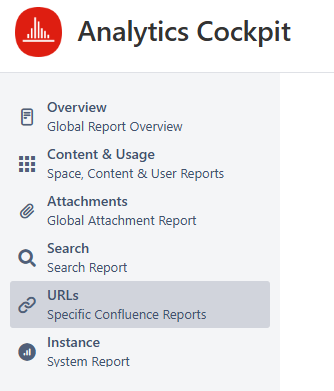
Screenshot highlighting the URL report entry
Elements of the Confluence URL Reports
The overview page displays default URLs that we’ve set up for tracking. You can activate tracking for any of these entries at any time to start monitoring them immediately and to access related reports.
We’ve added standard reports for the following 3rd-party apps:
Linchpin Intranet Suite by //Seibert/Media: tracking of News Hub, Event Hub, Launchpad, Microblog
Refined for Confluence | Sites & Themes: tracking of blogs overview, user dashboard and categories
Depending on your needs, you can set up customized trackings for other third-party app content or edit existing ones. This is explained in detail below.
Each report consists of the following elements:

Screenshot highlighting the URL Report elements
URL Tracking Name
Views: The accumulated visits of a specific report in the selected date range.
Tap the bar chart icon 📊 in the “Actions” column for a detailed view.
Status *: Tracking all the specific Confluence reports is disabled by default.
An administrator can use the toggle in the “Status” column to activate tracking for a specific report.
Restriction: Indicates whether a report has been restricted for certain user groups.
If it’s restricted, a red lock icon is displayed.
On mouse-over of the icon, the user groups are shown.
Actions:
Report icon: Tapping the bar chart icon 📊 will open a detailed view of the selected report. This is explained below.
Share icon: Tapping the share icon will display the URL to share the report. By default, all Confluence users who know this link can access the report. You can also restrict access (see below).
Edit *: Tapping on the edit menu item will display the editing window for changing details about the URL (its tracking name, description, actual URL, etc.) and assigning or changing access rights for this report.
Delete *: Tapping the delete menu item will irrevocably delete the tracking and its report.
* Only visible and accessible to administrators
Lists the default URL reports (in alphabetical order):
Name | Detail & How to access | URL or Regex |
|---|---|---|
All User Profiles | All user profile views accumulated Access via clicking on the user’s avatar or by searching for the desired user in the header under “People” and calling up their profile. | ^\/display\/~[^\/]+$|^\/users\/viewuserprofile\.action.$|^\/users\/viewmyprofile\.action.$ |
Blog Overview for each Space | All spaces' blog overviews views accumulated Access via space and its blog | /pages/viewrecentblogposts.action |
Calendar for each Space | All spaces' calendars views accumulated Access via space and its calendar | ^\/display\/[a-zA-Z0-9_-]+\/calendars |
Calendars | Main calendar views Access via the “Calendars” entry in the header | /calendar/mycalendar.action |
Linchpin Enterprise News (News Hub) | News Hub views Access via the News Hub entry in the header | /plugins/enterprise-news-bundle/news-center/view.action |
Linchpin Events (Event Hub) | Event Hub views Access via the Event Hub entry in the header | /plugins/easyevents/event-hub.action |
Linchpin Launchpad | Launchpad views Access via the Launchpad entry in the header | /plugins/appcenter/select.action |
Linchpin Microblog | Microblog views Access via the Microblog entry in the header | /plugins/microblog.action |
Main Dashboard | Confluence dashboard views
| ^\/((index|dashboard)\.action).$|^\/#.$|^\/$ |
People Directory | People directory views Access via the “people” entry in the header | /browsepeople.action |
Refined all blogs overview | All views of Refined blog overviews accumulated Access via the Refined Blogs navigation | /blog |
Refined all categories | All views of Refined categories accumulated Access via the Refined Categories navigation | /category/ |
Refined user dashboard | All views of Refined user dashboards accumulated Access via the Refined User Dashboard | /users/view-user-dashboard.action |
Space Directory | Space directory views Access via the “space” entry in the header and then selecting “space directory” | /spacedirectory/view.action |
Notes:
Users with the Global Report read-only access will see only reports their user is authorized to access on this overview.
If you are looking for a specific report not covered in this overview, please tap the “+ URL to track” button to create your customized URL tracking. We explain more about how to proceed below ⤵️ .
Specific Report: Detailed view
Clicking the bar chart icon opens a detailed report of the specific Confluence URL.
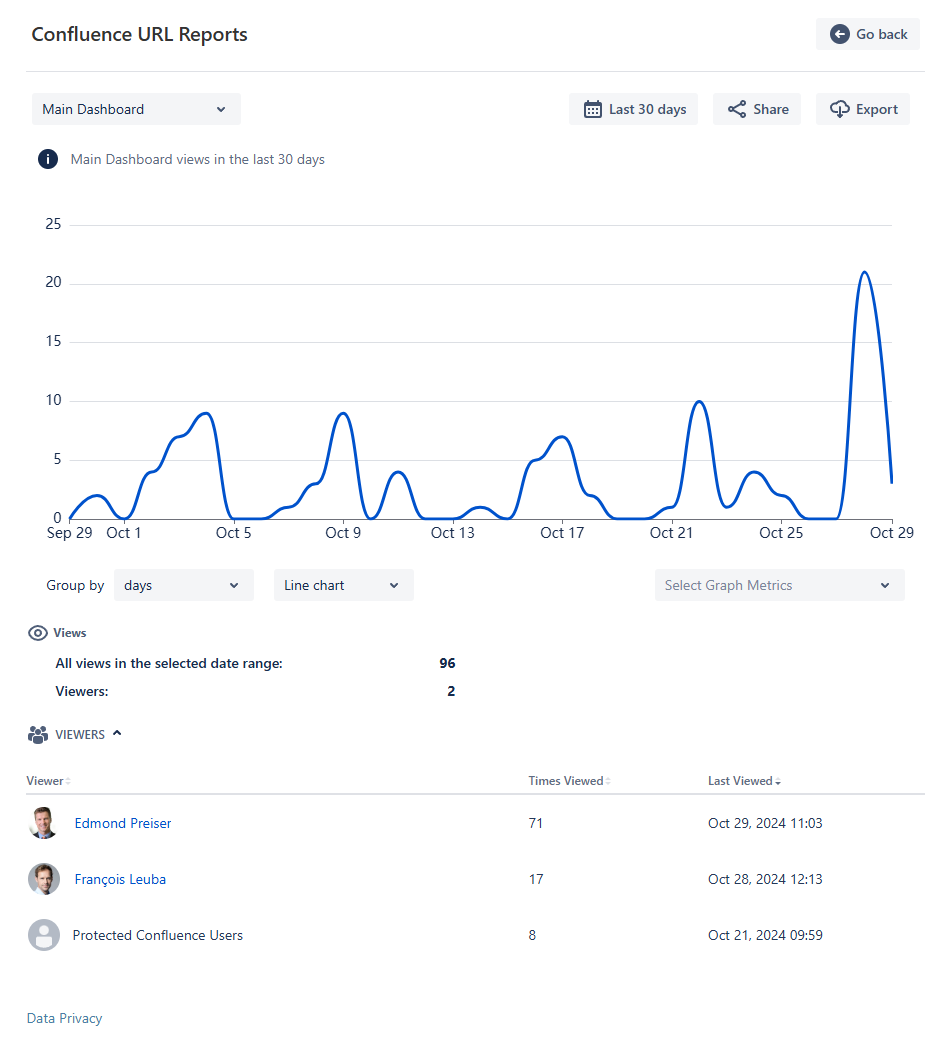
View of chart within the URL report entry
This report includes:
Drop-down Menu: Easily switch between reports using the menu, which lists only reports you have access to.
Share Option: Click the share icon to generate a shareable link for the report.
By default, any Confluence user with this link can access the report, though access restrictions are also available (see below).
Export button: The export option of this particular report (see below).
Graph with views and viewers in the selected date range.
The graph can be grouped by days (default), weeks, months, or years and displayed in a line (default), bar or area chart.
Table “views” contains “all views in the selected date range” and the number of total “viewers.”
Table “viewers” (expandable) with the individual viewers, sorted by the number of views and the last view date.
You can also use the “← Go Back” button to access the URL report overview again.
Notes
It can take up to 1 minute before views are displayed in the report.
Anonymous users with access to specific components (i.e., Space Directory) are tracked.
Exporting reports
You can export the data of each of the reports as a CSV file, Either as a list of each individual view or the aggregated views per user as listed in the report.
The aggregated data export is only available if the privacy setting allows Viewtracker to track and list individual users.
The individual view export contains: “Full Name", "Date and Time"
The aggregated view export contains: "Full Name", "Views", "Last Viewed"
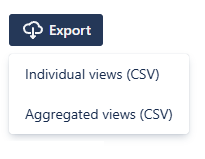
Export options within the URL Report
Add Tracking for Customized URLs
If you want to track a specific Refined category, Linchpin microblog topic, or any other unique Confluence output with its own URL, select the “+ URL to Track” button. This will open an input form where you can configure your custom URL tracking.
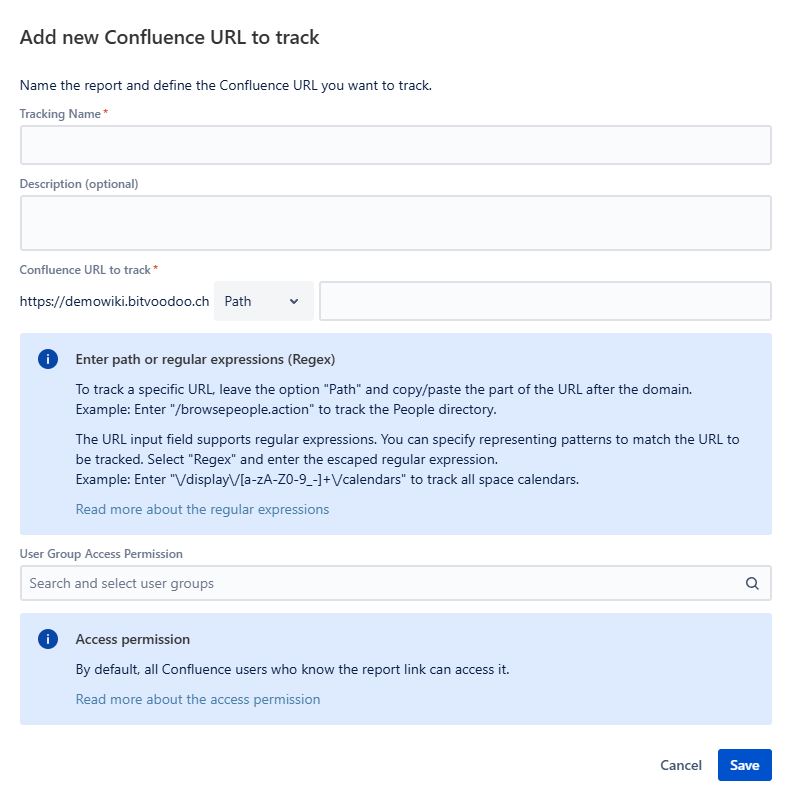
Screenshot of the form for adding a URL to track
In this form, you can find:
Tracking Name: Enter a clear, descriptive name for the new tracking, making it easy to identify later.
Description: Use this field to add any essential notes or relevant details about the tracking configuration. This can be helpful for keeping organized or explaining its purpose.
Confluence URL to track: When creating a new URL to track, you have two options in the dropdown:
Path:
This option is ideal for tracking specific Confluence outputs with distinct URLs, like:
Refined category
Linchpin microblog topic
Space Calendar
Space Blog Overview, etc.
To set this up:
Open the target content in your browser.
Copy the path from the URL, which will look like one of these examples:
Refined category →
/category/<NameKey>Linchpin microblog topic →
/plugins/microblog.action#topic/<TopicID>Space Calendar →
/display/<SpaceKey>/calendarsSpace Blog Overview →
/pages/viewrecentblogposts.action?key=<SpaceKey>Etc.
The <> value in these examples is a placeholder for the Refined Name Key, Linchpin Topic ID, and Confluence Space Key that will be displayed in your URL.
Add the path of your destination in the input field after the dropdown.

Example: Blog Overview of space “CEO”
2. Regex with Regex tester
Use this option only if you are familiar with regular expressions. A regex that is not targeted enough can lead to too many elements being tracked, which can decrease your Confluence instance's performance.
If you want to track multiple URLs using a regular expression, select “Regex” from the dropdown. The info panel will offer you the option to validate your regex.

Screenshot of the Regex Tester entry
Open the linked regex tester.
In the Target Confluence URL, enter one of the URL variants you want to track using your regex. Now, enter the regex in the URL above and tap “Verify” to check if your entry finds the target URL.
You need to enter an escaped regular expression (i.e.
\/display\/[a-zA-Z0-9_-]+\/calendars)You can use the tester to check all the target URLs you want to track.
You can close this window if the regex you entered here is correct.
Your regex will automatically be copied over in the regex input field of the entry mask.

Screenshot of the regex tester.
Notes for the tracking of URLs
Viewtracker already tracks pages, blog posts and attachments, and there are various built-in reports to analyze their performance.
We advise against setting up URL tracking for these contents.
You can set up tracking only for Confluence URLs (including 3rd-party Confluence apps).
It is not possible to track the content of other products running on the same server.
Apply Access Permissions:
All Confluence users can access the report by default if they know the shareable URL.
If you want to restrict access to the customized report to certain user groups, search and select them here.
If the required information for your new URL Tracking is provided, tap “Save.”

Screenshot of the Access Permission field.
Sharing this report
If a user uses the share button now, the window will point out the restricted access:
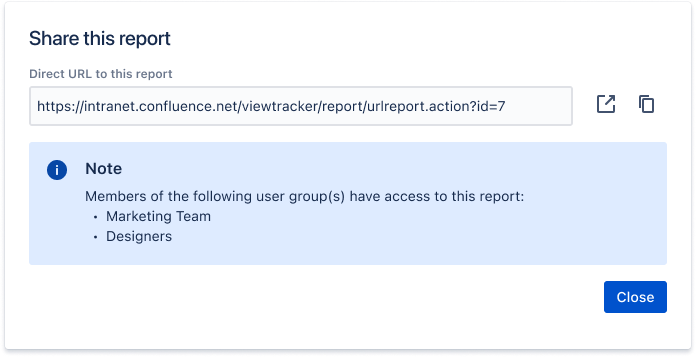
Sharing a report.
Activate your customized URL tracking
After saving your new entry, tracking for the target URL won’t begin immediately.
To start tracking, use the toggle switch under the “Status” column in the overview table.
You can activate or deactivate tracking as needed.

Screenshot highlighting the Status toggle.
